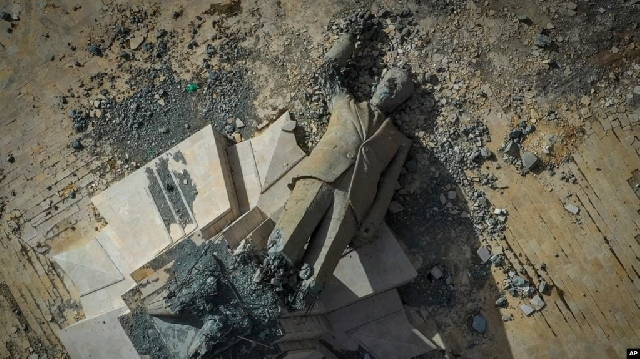Post-Assad Syria faces challenges in building unified military
 A statue of the late Syrian President Hafez Assad, which was toppled and defaced during the uprising that overthrew the Assad regime last December, lies in ruins atop a mountain in Dayr Atiyah, Syria, Jan. 5, 2025
A statue of the late Syrian President Hafez Assad, which was toppled and defaced during the uprising that overthrew the Assad regime last December, lies in ruins atop a mountain in Dayr Atiyah, Syria, Jan. 5, 2025
The newly appointed defense minister in Syria’s caretaker government, Murhaf Abu Qasra, has been holding meetings with various rebel factions in the country, aiming to bring them under the command of Syria’s defense ministry.
Abu Qasra said in a statement Monday that such meetings “aim to develop a roadmap for stabilizing the military’s organizational structure.”
Syria’s new authorities announced shortly after the ouster of former President Bashar al-Assad last month that unifying all rebel groups and other armed forces under a national military would be a top priority in the post-Assad era.
Dozens of rebel factions and armed forces emerged over the course of Syria’s conflict, which began in 2011, with the aim of either fighting the Assad regime or protecting local communities.
Before taking up his current role as defense minister, Abu Qasra served as a key commander in Hayat Tahrir al-Sham (HTS), the main rebel group that spearheaded the 11-day offensive culminating in Assad’s ouster on Dec. 8, 2024.
HTS, a U.S.-designated terrorist organization with former ties to al-Qaida, has emerged as the dominant force within Syria’s new leadership. Its leader Ahmad al-Sharaa, formerly known as Abu Mohammed al-Jolani, recently called on all armed groups in the country to join a unified military, pledging to dissolve the HTS as part of the process.
Nicholas Heras, a Middle East expert at the Washington-based New Lines Institute, said the HTS-led caretaker government is facing the reality that there are heavily armed, well-organized actors within Syria who mistrust its intentions and do not see it as the permanent successor to the Assad regime.
“The consequence of Syria’s multi-factional civil war is that despite the relative strength of HTS compared to other armed groups in western Syria, the HTS-led caretaker government is still limited in its resources and operating under the shadow of distrust and terrorist designation from powerful foreign actors,” he told VOA.
 | Fighters of Hayat Tahrir al-Sham (HTS) walk together during what they said was security checks to find "remnants" of ousted Syrian President Bashar al-Assad's force, in Wadi al-Dahab neighborhood in Homs, Syria, Jan. 2, 2025
| Fighters of Hayat Tahrir al-Sham (HTS) walk together during what they said was security checks to find "remnants" of ousted Syrian President Bashar al-Assad's force, in Wadi al-Dahab neighborhood in Homs, Syria, Jan. 2, 2025
One of the major groups that the interim government seeks to integrate into the Defense Ministry is the Syrian Democratic Forces (SDF).
The SDF, a Kurdish-led military alliance, has been a key U.S. partner in the fight against the Islamic State terror group. It controls a vast territory in northeast Syria, but Turkey considers it a terrorist organization and has vowed to eliminate it unless its fighters disarm. Since Assad’s fall, Turkish-backed Syrian proxies have intensified their clashes with the SDF in parts of northern Syria, dislodging them from several towns in Aleppo province.
The SDF has stated it will not lay down its arms without a genuine political process in Syria, one in which it can play a key role in shaping the country’s future military. Last week, a meeting took place between Syria’s de facto leader al-Sharaa and SDF officials in Damascus, but details of the discussion haven’t been disclosed.
“While I'm sure the group wants to do the right thing by the Syrian people and for the country of Syria, when locked in an existential fight against a powerful military like Turkey, not to mention threats from a resurgent Islamic State and other non-state armed groups, it would be crazy for the SDF to unilaterally disarm,” said Colin Clarke, director of research at The Soufan Group.
“The SDF's number one priority is survival, and Syria is not the kind of country where any minority group can afford to readily give up its arms, even if a government promises security and safety,” he told VOA.
 | Mourners hold portraits during the funeral of six Kurdish fighters from the Syrian Democratic Forces (SDF) killed in ongoing clashes with Turkish-backed militias in northern Syria, held in Qamishli, northeastern Syria, Dec. 26, 2024
| Mourners hold portraits during the funeral of six Kurdish fighters from the Syrian Democratic Forces (SDF) killed in ongoing clashes with Turkish-backed militias in northern Syria, held in Qamishli, northeastern Syria, Dec. 26, 2024
Analyst Heras believes there are limitations in the power of HTS to impose its order on Syria at this point, “because the Druze community in Sweida [in the south] doubts that HTS can restrain the more extremist elements in its coalition, the SDF will not surrender the autonomy of its region of control, and other actors such as the Southern Operations Room, the Turkish-backed Turkmen majority groups in northern Syria, the Christian militias in Homs, and the slowly gathering Alawite clans in the mountains by the coast are all demanding a stake in the future of Syria.”
He said militias in Syria, even many within the Sunni Arab community, “want HTS to bask in the glory of dealing the death blow to the Assad regime, and then exit left to allow a future Syrian state to take center stage. At this time, however, many of the Syrian militias believe that HTS is looking to replace the Baath [the former ruling party] with its own form of authoritarianism.”
Myles Caggins, a former spokesperson for the global coalition against IS, said the new government in Syria should take inclusive steps to secure international support.
“Syria must form a government that respects human rights, protects the rights of minorities and is inclusive, including within the security forces,” he told VOA. “Only then Syria will rise quickly to a place of international relevance.”
Source: voanews.com/Sirwan Kajjo
Trending World

Higher winds threaten to spread Los Angeles wildfires
00:39
Malala Yousafzai asks Muslim leaders to reject Taliban’s treatment of Afghan women openly
00:35
Somalia, Ethiopia to restore diplomatic ties amid AU mission agreement
16:53
Los Angeles fires death toll rises to at least 24
16:35
Qatar says Israel, Hamas at closest point yet to ceasefire deal
13:26
Israel and Hamas reach ceasefire deal
20:42
Botswana records grim gender-based violence statistics
20:39
South Korean investigators arrest impeached President Yoon
03:41
In farewell address, Biden warns of concentration of power and wealth
22:23
Israel agrees to hostage deal with Hamas
13:43



